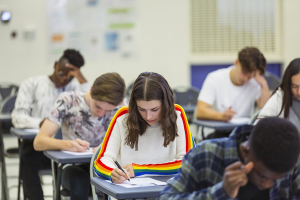Bible Break Helps Students, Study says
A secular group evaluates an off-campus program at Oakland public schools.
Releasing public school students for an hour of religious instruction off-campus can build positive character development and also boost academic performance, according to a study released Monday.
As school officials struggle with unruly behavior and low test scores, any solution to poor performance and low student motivation should be welcome, said Barry Krisberg, president of the National Council on Crime and Delinquency.
"An increasing number of studies are showing that religion has a positive impact on the behavior of students," said Krisberg, whose nonprofit group often does research for other entities. "In this study, it was interesting to find that academic performance was also significantly better than (that of) students who did not participate in the program."
Some critics, however, said the program walks dangerously close to using public schools to promote religion.
School Ministries Inc., which advocates Released Time Bible Education nationally, asked Krisberg's secular group to independently evaluate the Oakland released-time program.
NCCD studied about 75 fourth-and fifth-graders in the Oakland public school system. The students are taught by volunteer instructors about the Bible after youngsters first get permission from parents to skip one class period a week.
In Oakland, the curriculum also stresses reading and language skills.
NCCD found that, after participating in released-time Bible study for one academic year, the Oakland students tested higher in reading, language, and math than the other fourth-and fifth-graders.
The study also reported that released time provides students with adult mentors and reinforces positive moral and character development.
Overall, released time contributes positively to improving Oakland schools, which are historically mired near the bottom academically, Krisberg said.
"Released time is no panacea, but it is certainly helping these kids," he said.
Some groups caution against embracing released time. The Rev. Barry W. Lynn, executive director of Americans United for Separation of Church and State, said serious constitutional pitfalls lurk with released time.
"Some organizations have demanded that public schools help promote released-time programs," Lynn said. "The Supreme Court upheld off-campus released-time under certain conditions in 1952. This means that public schools may allow these programs, but they may not promote or help organize them."
Lynn said it is not surprising that children who receive additional reading and language instruction would do better.
"I expect we would have seen the same results with a secular reading program," he said.
Released-time education was started in 1914 by a public school superintendent in Gary, Ind.
School Ministries estimates that there are 250,000 students in at least 32 states who participate in released time, including a program in Sacramento. Most are taught by Protestant instructors.
However, Jewish and Roman Catholic students use released time on the East Coast. In Utah, members of the Church of Jesus Christ of Latter-day Saints are participants.
Many of the elementary school principals whose schools participate in the program spoke highly of the academic progress of released-time students.
But some principals worried that students use the program to get out of class. Many principals said schools need better counseling services -- not necessarily Bible study.
"The volunteers are very dedicated," Krisberg said. "A program like this creates a temporary safe haven inside an otherwise hostile school environment."
Overall, the study said, students enjoy learning about God, Jesus and the Bible. In their everyday life, they use what they learn in the program when it comes to manners, staying away from drugs and following the tenets of the Ten Commandments.
Maury Walker, president of the Sacramento program, said released time has shrunk locally since the 1970s, when 400 students and 20 volunteer teachers participated.
"My ultimate goal is to have 2,000 kids involved," he said. "In the meantime, I'm just trying to find teachers."
The released-time instruction is usually held in a teacher's home, located near the school. Some programs are held in churches near schools.
"Sixty percent of the kids who we have had over the past years have had no religious background," Walker said.
Lance Aguilar, an eighth-grader at Carmichael's Starr King Middle School, said his behavior improved when he joined the released-time program, leaving school once a week for Bible study instead of attending his sixth period science class.
Released time usually starts with a prayer before teacher Rebecca Moe begins Bible instruction. Usually, there are only a handful of students, he said.
"Everybody takes turns reading from the Bible," said Aguilar, 13. "Some of the words in the Bible helped me with reading, too. I'm hoping to go again this next school year."




























